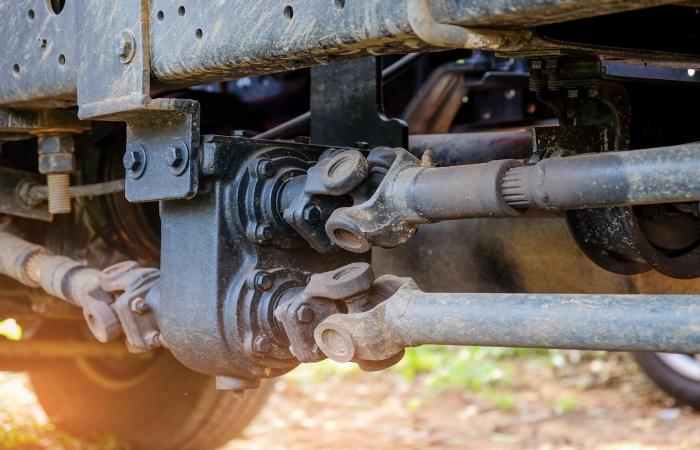Vibrations and shakes
When CV axle joints start to erode, they can create blind spots or trouble spots. If this happens, the axle will stand at a standstill while turning and during vehicle acceleration. This can cause vibrations or jolts in the front suspension area, which will rush through the car during acceleration and deceleration, where the steering wheel will most likely be the focal point.
buzzes and growls
Like many components, the CV axle and joints need lubrication to function smoothly in the constant heat that a car generates. If the lubrication begins to dissipate – probably through leaking axle boots – this can cause damage to the gears and wheel bearings. When this occurs, the vehicle will start to make a buzzing and growling noise as speed increases and lubrication decreases.
other noises
In addition to the buzz, a faulty CV axle can develop a host of sounds, such as “clicks,” “pops,” and clunking noises, as the damage to the axle joints worsens. If a knocking noise is heard while accelerating or decelerating, it may mean harm to the inner and outer CV joints. If knocking continues while driving at low speed, it may also be due to joint damage. Clicking or popping sounds may be indicative of a bad outer gasket. You should take the vehicle to a repair shop for further analysis if these noises occur.
What happens when a car’s ball joints break?
As part of the front suspension of many automobiles, ball joints support the vehicle’s weight and connect the tie rods, springs, shock absorbers and other suspension parts to the wheels. Over time, components begin to wear and loosen from repeated driving over potholes and other suspension parts connected to the ball joints breaking. The car can show various signs that the ball joints have started to fail. Noise
A metallic knock coming from the front end is the first sign that a vehicle’s ball joints have begun to fail. The sound is like someone hammering on a metal plate. This noise can increase over time and may or may not be heard all the time. In addition, it can increase when you make a turn, especially a tight one, and when going over potholes and speed bumps.
Touch the ground
The second sign of lousy ball joints is a loud grinding noise that sounds like the vehicle is skimming the ground. This sound may come from both kneecaps or one side only and may be accompanied by a tapping.
wheel review
Use a jack to raise the front wheels of the car. Place one hand on the bottom of one wheel and the other on top. Shake the wheel and try to listen for a knock. If you hear it, it means the kneecap is starting to give out.
Ball joint physical inspection
With the vehicle raised, locate the ball joints. They are made up of a rod with a ball at its end, inserted into a cylindrical housing, generally partially covered by rubber bellows, designed to retain the grease that lubricates the joint. Move the rubber bellows; if it moves freely along the joint, the patella is useless. If the bellows are dry and hard and move freely without the linkage, then the bellows are no longer helpful.
tire wear
Use a flashlight to check the tires while the vehicle is raised. If you notice ruts in the tire treads or irregular wear, one or more suspension components are failing, including the ball joints, springs, and stabilizer bars. This method of determining the condition of the ball joints is not 100 per cent sure, but it can indicate an early problem with the suspension.
Repair
Ball joints and bellows can be obtained from different auto parts stores and vendors. Consult a mechanical workshop if you are not trained or do not have the elements to make the change on your own.
What happens when a wheel bearing breaks?
Cars offer the freedom to drive freely on the road, using several intricately connected systems to propel the vehicle forward. Rolling along with the wheels are the axle bearings. Wheel rotation would be impossible without adequately aligned and lubricated bearings in the front and rear axles. Certain symptoms occur when one of these bearings reaches the end of its useful life. The function of the rear bearings
Axle bearings are part of the vehicle’s suspension and provide smooth wheel rotation. The rear wheel bearings are responsible for supporting the weight of the vehicle’s rear. A typical passenger car applies about 850 pounds (400 kg) of pressure on each bearing. Larger vehicles use even more, with approximately 1,500 pounds (680 kg) on each bearing for a standard 6,000-pound (2,700 kilograms) sport utility.
Symptoms of defective bearings
Discovering a faulty rear bearing usually means noise. The directions use a series of smooth balls that rotate relative to each other inside a narrow circular metal housing. A defective approach stops turning smoothly and begins to make a low-pitched hum. The noise does not change in pitch with acceleration or deceleration. However, it may decrease when turning. In this case, the suspicious bearing must checked immediately for the safety of the driver and other people on the road.
Dangers of a stuck bearing
A vehicle can lose one of its wheels due to a stuck axle bearing. Ignoring the constant noise of an approach can lead to it seizing up completely. The rotating spheres get stuck inside their housing due to the accumulation of dirt or lack of lubrication. When this happens, the rear axle stops turning completely and, along with it, the wheel stops. The stuck wheel can torn from the vehicle at high speeds, resulting in a potentially hazardous situation.


